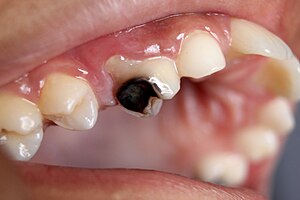
Back Tandbederf Afrikaans تسوس الأسنان Arabic Caries AST Laka k'ama Aymara Karies Azerbaijani Карыес зубоў Byelorussian Карыес зубоў BE-X-OLD Кариес Bulgarian দন্তক্ষয় Bengali/Bangla Karijes BS
| Tooth decay | |
|---|---|
| Other names | Dental cavities, dental caries, cavities, caries |
 | |
| Destruction of a tooth by dental caries and disease | |
| Pronunciation |
|
| Specialty | Dentistry |
| Symptoms | Pain, tooth loss, difficulty eating[1][2] |
| Complications | Inflammation around the tooth, tooth loss, infection or abscess formation[1][3] |
| Duration | Long term |
| Causes | Bacteria producing acid from food debris[4] |
| Risk factors | Diet high in simple sugar, diabetes mellitus, Sjögren syndrome, medications that decrease saliva[4] |
| Prevention | Low-sugar diet, tooth brushing, fluoride, flossing[2][5] |
| Medication | Paracetamol (acetaminophen), ibuprofen[6] |
| Frequency | 3.6 billion (2016)[7] |
Dental cavity, also known as tooth decay,[a] is the breakdown of teeth due to acids produced by bacteria.[6] The resulting cavities may be a number of different colors, from yellow to black.[1] Symptoms may include pain and difficulty eating.[1][2] Complications may include inflammation of the tissue around the tooth, tooth loss and infection or abscess formation.[1][3] Tooth regeneration is an ongoing stem cell–based field of study that aims to find methods to reverse the effects of decay; current methods are based on easing symptoms.
The cause of cavities is acid from bacteria dissolving the hard tissues of the teeth (enamel, dentin and cementum).[4] The acid is produced by the bacteria when they break down food debris or sugar on the tooth surface.[4] Simple sugars in food are these bacteria's primary energy source and thus a diet high in simple sugar is a risk factor.[4] If mineral breakdown is greater than buildup from sources such as saliva, caries results.[4] Risk factors include conditions that result in less saliva, such as diabetes mellitus, Sjögren syndrome and some medications.[4] Medications that decrease saliva production include antihistamines and antidepressants.[4] Dental caries are also associated with poverty, poor cleaning of the mouth, and receding gums resulting in exposure of the roots of the teeth.[6][8]
Prevention of dental caries includes regular cleaning of the teeth, a diet low in sugar, and small amounts of fluoride.[2][4] Brushing one's teeth twice per day, and flossing between the teeth once a day is recommended.[4][6] Fluoride may be acquired from water, salt or toothpaste among other sources.[2] Treating a mother's dental caries may decrease the risk in her children by decreasing the number of certain bacteria she may spread to them.[4] Screening can result in earlier detection.[6] Depending on the extent of destruction, various treatments can be used to restore the tooth to proper function, or the tooth may be removed.[6] There is no known method to grow back large amounts of tooth.[9] The availability of treatment is often poor in the developing world.[2] Paracetamol (acetaminophen) or ibuprofen may be taken for pain.[6]
Worldwide, approximately 3.6 billion people (48% of the population) have dental caries in their permanent teeth as of 2016.[7] The World Health Organization estimates that nearly all adults have dental caries at some point in time.[2] In baby teeth it affects about 620 million people or 9% of the population.[10] They have become more common in both children and adults in recent years.[11] The disease is most common in the developed world due to greater simple sugar consumption, but less common in the developing world.[6] Caries is Latin for "rottenness".[3]
- ^ a b c d e Laudenbach JM, Simon Z (November 2014). "Common Dental and Periodontal Diseases: Evaluation and Management". The Medical Clinics of North America. 98 (6): 1239–1260. doi:10.1016/j.mcna.2014.08.002. PMID 25443675.
- ^ a b c d e f g "Oral health Fact sheet N°318". World Health Organization. April 2012. Archived from the original on 8 December 2014. Retrieved 10 December 2014.
- ^ a b c Taber's cyclopedic medical dictionary (Ed. 22, illustrated in full color ed.). Philadelphia: F.A. Davis Co. 2013. p. 401. ISBN 978-0-8036-3909-6. Archived from the original on 2015-07-13.
- ^ a b c d e f g h i j k SECTION ON ORAL H, SECTION ON ORAL H (December 2014). "Maintaining and improving the oral health of young children". Pediatrics. 134 (6): 1224–9. doi:10.1542/peds.2014-2984. PMID 25422016. S2CID 32580232.
- ^ Cite error: The named reference
Oli2017was invoked but never defined (see the help page). - ^ a b c d e f g h Silk H (March 2014). "Diseases of the mouth". Primary Care: Clinics in Office Practice. 41 (1): 75–90. doi:10.1016/j.pop.2013.10.011. PMID 24439882. S2CID 9127595.
- ^ a b "Oral health". World Health Organization. Archived from the original on 2019-10-17. Retrieved 2019-09-14.
- ^ Schwendicke F, Dörfer CE, Schlattmann P, Page LF, Thomson WM, Paris S (January 2015). "Socioeconomic Inequality and Caries: A Systematic Review and Meta-Analysis". Journal of Dental Research. 94 (1): 10–18. doi:10.1177/0022034514557546. PMID 25394849. S2CID 24227334.
- ^ Otsu K, Kumakami-Sakano M, Fujiwara N, Kikuchi K, Keller L, Lesot H, Harada H (2014). "Stem cell sources for tooth regeneration: current status and future prospects". Frontiers in Physiology. 5: 36. doi:10.3389/fphys.2014.00036. PMC 3912331. PMID 24550845.
- ^ Vos T (Dec 15, 2012). "Years lived with disability (YLDs) for 1160 sequelae of 289 diseases and injuries 1990–2010: a systematic analysis for the Global Burden of Disease Study 2010". The Lancet. 380 (9859): 2163–96. doi:10.1016/S0140-6736(12)61729-2. PMC 6350784. PMID 23245607.
- ^ Bagramian RA, Garcia-Godoy F, Volpe AR (February 2009). "The global increase in dental caries. A pending public health crisis". American Journal of Dentistry. 22 (1): 3–8. PMID 19281105.
Cite error: There are <ref group=lower-alpha> tags or {{efn}} templates on this page, but the references will not show without a {{reflist|group=lower-alpha}} template or {{notelist}} template (see the help page).